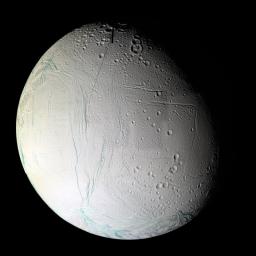Numerous blue-green fractures can be seen in this false-color mosaic taken during Cassini's second close flyby of Enceladus, on March 9, 2005.
The mosaic shows the anti-Saturnian hemisphere of Enceladus -- the side that always faces away from Saturn. This region contains a number of tectonic and impact features and shows how these two geologic forces interact on Enceladus. The center left portion of this mosaic is dominated by Diyar Planitia. Like Sarandib Planitia observed in the previous Enceladus flyby, the region is characterized by low ridges and troughs. Throughout this hemisphere, fractures of all sizes disrupt the previously existing cratered terrain and even the comparatively youthful Diyar Planitia.
Many of the younger fractures have blue-green walls, revealing coarse-grained water ice in the top layers of Enceladus' lithosphere, compared to the fine-grained ice that coats much of Enceladus' surface. The blue-green color is very similar to the coatings surrounding the south polar "tiger stripes" (these appear greener than the features in the south polar mosaic released in 2005 (see PIA07800) due to the use of clear-filter images, instead of green, in that mosaic).
A higher resolution cropped section of this mosaic is available in PIA08355.
This mosaic consists of 25 false-color footprints (75 images total) taken by the Cassini spacecraft's narrow-angle camera. The mosaic uses an ultraviolet filter centered at 338 nanometers for blue, a green filter centered at 568 nanometers for green and a near-infrared filter centered at 930 nanometers for red -- thus covering a wider spectrum region than the human eye. To create a single, full-disk mosaic, the images were reprojected into an orthographic projection centered at 1.5 degrees south latitude, 204 degrees west longitude with a pixel scale of 90 meters (295 feet) per pixel. The black strip seen at the top of the mosaic is an unfilled seam between two images.
The original images were taken from distances ranging from 4,300 to 31,800 kilometers (2,670 to 19,760 miles). The images have a phase, or sun-Enceladus-spacecraft, angle of 45 degrees.
The Cassini-Huygens mission is a cooperative project of NASA, the European Space Agency and the Italian Space Agency. The Jet Propulsion Laboratory, a division of the California Institute of Technology in Pasadena, manages the mission for NASA's Science Mission Directorate, Washington, D.C. The Cassini orbiter and its two onboard cameras were designed, developed and assembled at JPL. The imaging operations center is based at the Space Science Institute in Boulder, Colo.
For more information about the Cassini-Huygens mission visit http://saturn.jpl.nasa.gov/home/index.cfm. The Cassini imaging team homepage is at http://ciclops.org.

 Planetary Data System
Planetary Data System












